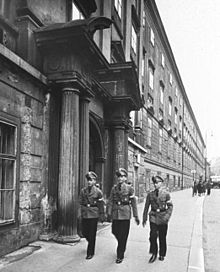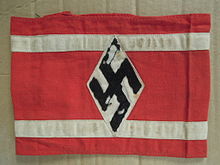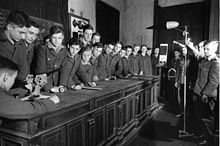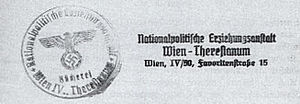National Political Institutes of Education
- For the German film, Before the Fall.
This article needs additional citations for verification. (March 2016) |




National Political Institutes of Education (Template:Lang-de; officially abbreviated NPEA, commonly abbreviated Napola for Nationalpolitische Lehranstalt meaning National Political Institution of Teaching) were secondary boarding schools in Nazi Germany. They were founded as "community education sites" after the National Socialist seizure of power in 1933.
Mission
The main task of the NPEA was the "education of national socialists, efficient in body and soul for the service to the people and the state". The pupils attending these schools were meant to become the future leadership of Germany- political, administrative, and military. Until the beginning of World War II on 1 September 1939, the Napolas served as strong politically-accentuated elite preparatory schools within the framework of the general higher education system. During the war, they increasingly developed into preparatory schools for entry into the Wehrmacht and Waffen-SS. In keeping with their unique nature, Napola schools operated separate from all other German secondary schools.
Overview
The first three NPEAs were founded in 1933 by the Minister of Education Bernhard Rust in Plön, Potsdam and Köslin. The schools responded directly to the Reich Ministry for Education, rather than to any state like regular schools. From 1936, the NPEAs were subordinated to the Inspector of the National Political Institutes of Education, SS-Obergruppenführer August Heissmeyer. From August 1940 forward, they were part of the Hauptamt Dienststelle Heissmeyer.[1] Going forward, the schools were under the direct influence of the SS, which supplied and supported them.[1] The goal of the schools was to train future leaders, and especially given the influence of the SS, it was hoped that graduates would choose a career in the SS or police.[1] By 1941 there were 30 NPEAs with 6,000 pupils enrolled in all of Nazi Germany. The Napola schools were gender-segregated, and only a few girls-only Napola schools existed. In 1942, out of the 33 Napola schools that were operating, just three were for girls. By the end of the war in 1945, 43 Napola schools were listed.[1]
For boys aged 10–14 years old, the uniform of the Deutsches Jungvolk, or German Youngfolk, was used. For those aged 14–18 years old, the uniform of the Hitler Youth was used instead. The rank structure used corresponded with that present in these two organizations. Heissmeyer considered introducing uniforms and ranks similar to the SS among pupils and teachers, but ultimately kept the Hitler Youth organizational structure.
Due to the highly-militaristic nature of Nazi Germany, life at the NPEAs was dominated by military discipline.[2] Only boys and girls considered to be "racially flawless" were admitted to the boarding schools. This meant that no children with poor hearing or vision were accepted. "Above-average intelligence" was also required, so that those looking to be admitted had to complete 8-day entrance exams.[3]
Life in boys' Napolas was highly-competitive, even brutal. It was extremely hard to get in and nearly as hard to stay. Approximately one fifth of all cadets failed to meet the required standards or were sent home because of injuries sustained in training accidents.

Napola schools were intensely political, deliberately working to make their cadets fervent believers in the Nazi regime and its ideology. This is reflected in the percentage of Jungmannen who eventually entered the SS- 13%, much higher than the 1.8% of the general German population.[4]
The National Socialist world view was considered paramount in Napola education. A prominent belief among the cadets themselves was that of "Endsieg" or final victory. This came into play as Germany's fortunes fell into a decline from which they would never recover, and Nazi leadership increasingly scraped the bottom of the barrel for manpower. The privileged students of the Napola schools were mobilized in the final months of the war, serving as poorly equipped and minimally trained but highly motivated infantry. Armed with little more than blind fanaticism, they nonetheless offered fierce resistance in many battles in the last months of the war. Casualties among them were extremely high.
School locations
| City | Official Title | Region | Founded | Former use |
|---|---|---|---|---|
| Plön | NPEA Plön | Schleswig-Holstein | 1 May 1933 | Stabila (Staatliche Bildungsanstalt, "National Education Facility") |
| Potsdam | NPEA Potsdam | Brandenburg | 26 May 1933 | Stabila |
| Köslin | NPEA Köslin | Pomerania (today Poland) | 15 July 1933 | Stabila |
| Berlin-Spandau | NPEA Berlin-Spandau | Berlin | 30 January 1934 | Prussian Academy for Gymnastics; school for teachers |
| Naumburg | NPEA Naumburg | Prussian Province of Saxony | 15 March 1934 | Stabila/Military school |
| Ilfeld | NPEA Ilfeld | Prussian province of Hanover/Prussian Province of Saxony | 20 April 1934 | Cloisters/Seminary |
| Wahlstatt | NPEA Wahlstatt | Silesia (today Poland) | 9 April 1934 | Stabila |
| Oranienstein | NPEA Oranienstein | Prussian province of Hesse-Nassau | 1934 | Military school/Realgymnasium/Castle |
| Stuhm | NPEA Stuhm | East Prussia (today Poland) | 1 October 1934 | Barracks |
| Ballenstedt | NPEA Anhalt | Anhalt | May 1934 | City Gymnasium (secondary school) |
| Dresden-Klotzsche | NPEA Dresden Klotzsche | Saxony | 1 April 1934 | Landesschule |
| Backnang | NPEA Backnang | Württemberg | 2 May 1934 | Teacher Seminary |
| Bensberg | NPEA Bensberg | Prussian Rhine Province | 1 June 1935 | Military school/Castle |
| Schulpforta | NPEA Schulpforta | Prussian Province of Saxony | 1 July 1935 | Landesschule zu Pforta (state school Pforta, currently Landesschule Pforta in Saxony-Anhalt) |
| Rottweil | NPEA Rottweil | Württemberg | 1 April 1936 | Catholic Seminary |
| Neuzelle | NPEA Neuzelle | Brandenburg | 1934/1938 | Abbey (Stift), Boarding school for girls |
| Wien-Theresianum | NPEA Wien-Theresianum | Vienna (Austria) | 13 March 1939 | Academy |
| Wien-Breitensee | NPEA Wien-Breitensee | Vienna (Austria) | 13 March 1939 | Austrian Federal School (Bundeserziehungsanstalt) (Kommandogebäude Theodor Körner part of the Breitensee Barracks in Vienna) |
| Traiskirchen | NPEA Traiskirchen | Lower Danube (Austria) | 13 March 1939 | Austrian Federal School (Bundeserziehungsanstalt) |
| Ploschkowitz (Ploskovice) | NPEA Sudetenland | Sudetenland (today Czech Republic) | 10 October 1940 | Ploskovice Castle |
| Reisen (Rydzyna) | NPEA Wartheland | Warthegau (today Poland) | 1940 | Polish boarding school for boys in Rydzyna Castle |
| Loben | NPEA Loben | (East-) Upper Silesia (today Poland) | 1 April 1941 | School for children with speech impediments |
| Putbus | NPEA Rügen | Pomerania | 1 September 1941 | Pädagogium (Stift) |
| Reichenau | NPEA Reichenau | Baden | 1941 | Hospice |
| St Wendel | NPEA St Wendel | Saarland | 1 September 1941 | International School of the Steyler Mission |
| Weierhof bei Marnheim | NPEA am Donnersberg | Bavaria (Saar Palatinate) | 1941 | Gau-Oberschule (Reich regional secondary school?) |
| Sankt Paul im Lavanttal | NPEA Spanheim in Kärnten | Carinthia (Austria) | 1941 | Benedictine Abbey |
| Vorau | NPEA Gottweig | Styria (Austria) | January 1943 | Augustine Abbey |
| Seckau | NPEA Seckau | Styria (Austria) | 1941 | Benedictine Abbey (Stift) |
| Rufach | NPEA Rufach | Alsace (today France) | October 1940 | Hospice |
| Haselünne | NPEA Emsland | Prussian province of Hanover | 17 October 1941 | Cloister/Seminary for the Ursuline Order |
| Neubeuern | NPEA Neubeuern | Bavaria | May 1942 | Castle and state boarding school |
| St Veit | NPEA St Veit | Slovenia | July 1942 | Catholic Seminary and Gymnasium |
| Mokritz | NPEA Mokritz | Styria (Austria) | 1942 | Castle |
| Achern | NPEA Achern | Baden | August 1943 | The Illenau Sanatorium and Hospice |
| Kuttenberg (Kutná Hora) | NPEA Böhmen | Protectorate of Bohemia and Moravia | 22 April 1944 | Jesuit college and barracks |
| Raudnitz an der Elbe (Roudnice nad Labem) | NPEA Raudnitz | Protectorate of Bohemia and Moravia | July 1944 | Roudnice Castle |
Well-known former students
Well-known former students of National Political Institutes of Education include:
- Heinz Dürr (businessman)
- Manfred Ewald (athletic official)
- Alfred Herrhausen (businessman)
- Horst Janssen (printmaker)
- Hellmuth Karasek (journalist and author)
- Hardy Krüger (actor)
- Johannes Poeppel (general)
- Theo Sommer (journalist)
- Rüdiger von Wechmar (diplomat)
- Heinz Hitler (nephew of Adolf Hitler)
See also
Notes
- ^ a b c d Yerger 1997, p. 20.
- ^ (in German)Kleinhans, Bernd:Das Erbe der NAPOLA - von Christian Schneider in shoa.de. Retrieved October 1, 2006.
- ^ Nationalpolitische Erziehungsanstalten in Austrian Lexicon. Retrieved October 1, 2006.
- ^ Die Elite-Schule der Nazis
References
- Yerger, Mark C. (1997). Allgemeine-SS: The Commands, Units, and Leaders of the General SS. Atglen, PA: Schiffer. ISBN 0-7643-0145-4.
{{cite book}}: Invalid|ref=harv(help)
External links
